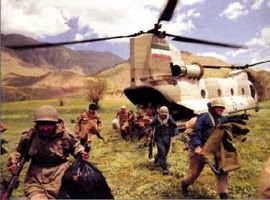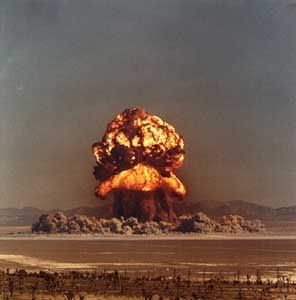Parthian-Iraqi War

| |||||||||||||||||
| Parthian-Iraqi War | |||||||||||||||||
|---|---|---|---|---|---|---|---|---|---|---|---|---|---|---|---|---|---|
| Date | December 03, 1983 - January 3rd, 1984 | ||||||||||||||||
| Place | Parthia, Iraq | ||||||||||||||||
| Result | Iraq annexed by Parthia. | ||||||||||||||||
| |||||||||||||||||
The Parthian-Iraqi War was an armed conflict which broke out between the Monarchial, Iranian Parthian state, and the Baathist dictatorship of Saddam Hussein after civil unrest in Parthia prompted an Iraqi invasion. It has often been considered one of the bloodiest conflicts of the later half of the twentieth century, seeing the use of Chemical, and nuclear weapons in significant numbers, which resulted in widespread destruction of much of the Iraqi nation along the former frontlines. While Parthian forces took relativley severe losses, the poorly coordinated Iraqi forces were slaughtered en masse in unprecedented numbers, while Iraqi civilians were often targetted after WMD attacks upon Parthian forces.
Contents
Background
The seeds of the Parthian-Iraqi war were set by the 1975 Arvandrud Skirmish, where the new model army of Shah Ardeshir XI was tested in conflict with Iraq after Iraq's government levied a claim over the entire Arvandrud (known in Arabic as the Shaat-al Arab). In response, Shah Ardeshir mobilized the Parthian army and sent it en masse upon the Iraqis. For three days, Parthian forces poured across the border and took up positions within artillery range of Basra, which was heavily bombarded, before withdrawing under UN pressure, after securing the entirety of the Arvandrud as Parthian territory, up to 1 meter from the Iraqi side of the river. When Saddam Hussein seized power in Iraq, he was intent on taking the Arvandrud back, in its entirety, and looked for a position where he could do so with the Iraqi army. Ultimately, it would mean the death of his country.
Ethnic Conflict and the Iraqi Invasion
On November 20th, 1983, Ethnic Arabs in Parthia's Khuzestan province began a massive strike against what they called Persian and Iranian oppression. The 50% Arab province of Khuzestan, containing most of the Parthian oil reserves rapidly ground to a halt, and the Shah's attempts to break the strikes with military force only managed to bring other ethnic revolts in Tabriz amongst the Azeris and in Chah Bahar amongst the Balochis, forcing tens of thousands of troops to retake the rebellious areas in campaigns of terror against dissidents which included such measures as taking whole families with members involved in the strikes or unrest and shooting them. Whole sections of Tabriz were destroyed by airstrikes, and much of the low-income neighborhoods of the city were utterly incinerated. In desperation, the Ahwazi Arabs called for assistance to Iraq, asking for Saddam Hussein to intervene in the name of Arab nationalism. Only too willing to help himself to the Parthian oil, Saddam launched his assault on December 3rd, declaring war only 25 minutes before unloading a barrage of artillery upon the opposite bank of the Shaat Al-Arab and beginning an assault into the Parthian city of Khorramshahr.
The Battle of Khorramshahr
3 Iraqi divisions crossed the Shaat Al-Arab initially after a massed artillery barrage and heavy airstrikes, moving directly towards the city of Khorramshahr and forcing the Parthian garrison to hold as best they could while they attempted to buy time for civilians to escape. The 344th Infantry Regiment, consisting of fewer than 1,500 men, managed to hold the defenses of Khorramshahr for almost one day, before retreating when the Iraqis brought two further divisions against them. It had bought enough time for two Parthian divisions to be brought into combat, along with enabling the much superior Parthian airforce to begin massed operations against Iraqi forces. Parthian F-15s began to tear the Iraqi airforce apart in Khorramshahr, while ground attack aircraft forced Iraqi armor to hide in the dense urban environment of Khorramshahr, enabling the Parthians to begin the counteroffensive.
Operation Aniran
The rapid Parthian counteroffensive was brought about due to two main factors, first, the Shah's ability to mobilize enough forces to engage the Iraqis, and second, the Parthian superiority in the air which enabled them to tear the larger, but more poorly equipped Iraqi forces to shreds. This advantage was decided to be brought to bear by exploiting the poor morale of the Iraqis and creating a total rout. The first step was to create a massed diversion, by attempting to retake Khorramshahr, while the real blow would come from five divisions in Illam which would push directly towards Bagdhad and take the city. On December 15th, the operations both opened, with the Parthian forces intially moving towards Khorramshahr and assaulting the city, suffering heavy losses and withdrawing, but the main assault unexpectedly pushed right across the border, taking a swathe of towns and moving directly towards Bagdhad.
Saddam's Response
The newest assault worried Saddam Hussein, forcing him to call all possible reserves to set up a line of defense East of Baghdad to defend his capital from a certain Parthian assault. By December 17th, the Parthians were already bearing down on the 8 Divisions of Iraqi forces defending the capital, and once the assault began, Iraqi forces unleashed a barrage of sulphur-mustard and tabun on Parthian forces, creating a total of 10,000 dead and over 25,000 wounded within a single day and preventing further Parthian advance. Furthermore, 45 SCUD missiles were launched at Parthian cities, killing over 5500 civilians. Now, the Shah had determined he would make an example of Iraq, showing to the world the power of Parthia.
Aniran II
The initial response to Saddam's Chemical barrage fell on Basrah, where the 2nd Army Corps, rather than taking Khorramshahr, moved on the city, unleashing a barrage of VX gas upon the mostly undefended and suprised city, before moving into the urban area, butchering the survivors of the attack, often by crucifixion or impaling, while others looted and burned the city. Basrah was wiped off the face of the earth, and the entire population exterminated.
Operation Mehr-e Ohrmazd and Parthian Victory
On January 1st, the situation had boiled down to a stalemate, with Parthian and Iraqi
including Saddam Hussein were roasted alive in the flames, which left the entire city in ruins. On January 3rd, Parthian forces occupied Bagdhad, and in a ceremony, declared Iraq to be Parthian territory and established the new capital of Ctesiphon for the province of Mesopotamia, once the seat of Persian government, it now is one of the greatest cities of the Parthian Empire.
